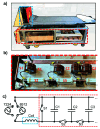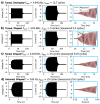Measurement of Peripheral Nerve Magnetostimulation Thresholds of a Head Solenoid Coil Between 200 Hz and 88.1 kHz
- PMID: 40740830
- PMCID: PMC12310169
- DOI: 10.1109/JTEHM.2025.3570611
Measurement of Peripheral Nerve Magnetostimulation Thresholds of a Head Solenoid Coil Between 200 Hz and 88.1 kHz
Abstract
Magnetic fields switching at kilohertz frequencies induce electric fields in the body, which can cause peripheral nerve stimulation (PNS). Although magnetostimulation has been extensively studied below 10 kHz, the behavior of PNS at higher frequencies remains poorly understood. This study aims to investigate PNS thresholds at frequencies up to 88.1 kHz and to explore deviations from the widely accepted hyperbolic strength-duration curve (SDC).PNS thresholds were measured in the head of 8 human volunteers using a solenoidal coil at 16 distinct frequencies, ranging from 200 Hz to 88.1 kHz. A hyperbolic SDC was used as a reference to compare the frequency-dependent behavior of PNS thresholds.Contrary to the predictions of the hyperbolic SDC, PNS thresholds did not decrease monotonically with frequency. Instead, thresholds reached a minimum near 25 kHz, after which they increased by an average of 39% from 25 kHz to 88.1 kHz across subjects. This pattern indicates a significant deviation from previously observed behavior at lower frequencies.Our results suggest that PNS thresholds exhibit a non-monotonic frequency dependence at higher frequencies, diverging from the traditional hyperbolic SDC. These findings offer critical data for refining neurodynamic models and provide insights for setting PNS safety limits in applications like MRI gradient coils and magnetic particle imaging (MPI). Further investigation is needed to understand the biological mechanisms driving these deviations beyond 25 kHz. Clinical impact -These findings call for further basic research into biological mechanisms underlying high frequency PNS threshold trends, and supports refinement of safety guidelines for MRI and MPI systems for clinical implementation.
Keywords: High frequency magnetostimulation; MRI gradient safety; magnetic particle imaging (MPI); magnetic resonance imaging (MRI); peripheral nerve stimulation.
© 2025 The Authors.
Figures







Update of
-
Measurement of peripheral nerve magnetostimulation thresholds of a head solenoid coil between 200 Hz and 88.1 kHz.Res Sq [Preprint]. 2024 Oct 14:rs.3.rs-4864083. doi: 10.21203/rs.3.rs-4864083/v1. Res Sq. 2024. Update in: IEEE J Transl Eng Health Med. 2025 May 15;13:275-285. doi: 10.1109/JTEHM.2025.3570611. PMID: 39483914 Free PMC article. Updated. Preprint.
Similar articles
-
Measurement of peripheral nerve magnetostimulation thresholds of a head solenoid coil between 200 Hz and 88.1 kHz.Res Sq [Preprint]. 2024 Oct 14:rs.3.rs-4864083. doi: 10.21203/rs.3.rs-4864083/v1. Res Sq. 2024. Update in: IEEE J Transl Eng Health Med. 2025 May 15;13:275-285. doi: 10.1109/JTEHM.2025.3570611. PMID: 39483914 Free PMC article. Updated. Preprint.
-
Prescription of Controlled Substances: Benefits and Risks.2025 Jul 6. In: StatPearls [Internet]. Treasure Island (FL): StatPearls Publishing; 2025 Jan–. 2025 Jul 6. In: StatPearls [Internet]. Treasure Island (FL): StatPearls Publishing; 2025 Jan–. PMID: 30726003 Free Books & Documents.
-
Reassessment of peripheral nerve stimulation thresholds for the Impulse model-optimized asymmetric head gradient coil.Magn Reson Med. 2025 Sep;94(3):1326-1338. doi: 10.1002/mrm.30523. Epub 2025 May 23. Magn Reson Med. 2025. PMID: 40407720 Free PMC article.
-
Ultrasound guidance for upper and lower limb blocks.Cochrane Database Syst Rev. 2015 Sep 11;2015(9):CD006459. doi: 10.1002/14651858.CD006459.pub3. Cochrane Database Syst Rev. 2015. PMID: 26361135 Free PMC article.
-
Systemic pharmacological treatments for chronic plaque psoriasis: a network meta-analysis.Cochrane Database Syst Rev. 2021 Apr 19;4(4):CD011535. doi: 10.1002/14651858.CD011535.pub4. Cochrane Database Syst Rev. 2021. Update in: Cochrane Database Syst Rev. 2022 May 23;5:CD011535. doi: 10.1002/14651858.CD011535.pub5. PMID: 33871055 Free PMC article. Updated.
References
-
- Barksdale A., et al. , “Measured PNS thresholds in a human head MPI solenoid from 200 Hz to 88.1 kHz,” Int. J. Magn. Part. Imaging, vol. 10, no. 1, 2024.
-
- Schaefer D. J., Bourland J. D., and Nyenhuis J. A., “Review of patient safety in time-varying gradient fields,” J. Magn. Reson. Imag., vol. 12, no. 1, pp. 20–29, Jul. 2000. - PubMed
-
- Den Boer J. A., et al. , “Comparison of the threshold for peripheral nerve stimulation during gradient switching in whole body MR systems,” J. Magn. Reson. Imag., vol. 15, no. 5, pp. 520–525, May 2002. - PubMed
-
- Recoskie B. J., Scholl T. J., and Chronik B. A., “The discrepancy between human peripheral nerve chronaxie times as measured using magnetic and electric field stimuli: The relevance to MRI gradient coil safety,” Phys. Med. Biol., vol. 54, no. 19, pp. 5965–5979, Oct. 2009. - PubMed
-
- Medical Electrical Equipment-part 2-33: Particular Requirements for the Basic Safety and Essential Performance of Magnetic Resonance Equipment for Medical Diagnosis, IEC Standard 60601-2-33Ed.3.0, I. E. Commission, 2010.
Publication types
MeSH terms
Grants and funding
LinkOut - more resources
Full Text Sources
Miscellaneous

